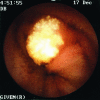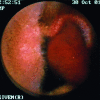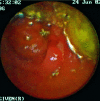Wireless capsule endoscopy: a comparison with push enteroscopy in patients with gastroscopy and colonoscopy negative gastrointestinal bleeding
- PMID: 12865269
- PMCID: PMC1773749
- DOI: 10.1136/gut.52.8.1122
Wireless capsule endoscopy: a comparison with push enteroscopy in patients with gastroscopy and colonoscopy negative gastrointestinal bleeding
Abstract
Background: The development of wireless capsule endoscopy allows painless imaging of the small intestine. Its clinical use is not yet defined. The aim of this study was to compare the clinical efficacy and technical performance of capsule endoscopy and push enteroscopy in a series of 50 patients with colonoscopy and gastroscopy negative gastrointestinal bleeding.
Methods: A wireless capsule endoscope was used containing a CMOS colour video imager, transmitter, and batteries. Approximately 50,000 transmitted images are received by eight abdominal aerials and stored on a portable solid state recorder, which is carried on a belt. Push enteroscopy was performed using a 240 cm Olympus video enteroscope.
Results: Studies in 14 healthy volunteers gave information on normal anatomical appearances and preparation. In 50 patients with gastrointestinal bleeding and negative colonoscopy and gastroscopy, push enteroscopy was compared with capsule endoscopy. A bleeding source was discovered in the small intestine in 34 of 50 patients (68%). These included angiodysplasia (16), focal fresh bleeding (eight), apthous ulceration suggestive of Crohn's disease (three), tumour (two), Meckel's diverticulum (two), ileal ulcer (one), jejunitis (one), and ulcer due to intussusception (one). One additional intestinal diagnosis was made by enteroscopy. The yield of push enteroscopy in evaluating obscure bleeding was 32% (16/50). The capsule identified significantly more small intestinal bleeding sources than push enteroscopy (p<0.05). Patients preferred capsule endoscopy to push enteroscopy (p<0.001).
Conclusions: In this study capsule endoscopy was superior to push enteroscopy in the diagnosis of recurrent bleeding in patients who had a negative gastroscopy and colonoscopy. It was safe and well tolerated.
Figures





Similar articles
-
Wireless capsule endoscopy in patients with obscure gastrointestinal bleeding: a comparative study with push enteroscopy.Aliment Pharmacol Ther. 2004 Jul 15;20(2):189-94. doi: 10.1111/j.1365-2036.2004.02067.x. Aliment Pharmacol Ther. 2004. PMID: 15233699
-
Capsule endoscopy and push enteroscopy in the diagnosis of obscure gastrointestinal bleeding.Chin Med J (Engl). 2004 Jul;117(7):1045-9. Chin Med J (Engl). 2004. PMID: 15265380
-
A prospective comparative study of push and wireless-capsule enteroscopy in patients with obscure digestive bleeding.Acta Gastroenterol Belg. 2003 Jul-Sep;66(3):199-205. Acta Gastroenterol Belg. 2003. PMID: 14618949 Clinical Trial.
-
Wireless capsule endoscopy and double-balloon enteroscopy for the diagnosis of obscure gastrointestinal bleeding.Tech Vasc Interv Radiol. 2004 Sep;7(3):130-5. doi: 10.1053/j.tvir.2004.12.004. Tech Vasc Interv Radiol. 2004. PMID: 16015557 Review.
-
Capsule Endoscopy in the Assessment of Obscure Gastrointestinal Bleeding: An Economic Analysis.Ont Health Technol Assess Ser. 2015 Feb 1;15(2):1-32. eCollection 2015. Ont Health Technol Assess Ser. 2015. PMID: 26355732 Free PMC article. Review.
Cited by
-
Ensure preparation and capsule endoscopy: a two-center prospective study.World J Gastroenterol. 2013 Feb 28;19(8):1264-70. doi: 10.3748/wjg.v19.i8.1264. World J Gastroenterol. 2013. PMID: 23483023 Free PMC article. Clinical Trial.
-
An unexpected finding in a child with rectal blood loss using video capsule endoscopy.Eur J Pediatr. 2006 Apr;165(4):270-2. doi: 10.1007/s00431-005-0057-0. Epub 2006 Jan 13. Eur J Pediatr. 2006. PMID: 16411089 No abstract available.
-
Capsule endoscopy: improving transit time and image view.World J Gastroenterol. 2005 Oct 7;11(37):5863-6. doi: 10.3748/wjg.v11.i37.5863. World J Gastroenterol. 2005. PMID: 16270399 Free PMC article.
-
Laparoscopic resection of a small bowel lipoma with incidental intussusception.JSLS. 2010 Oct-Dec;14(4):615-8. doi: 10.4293/108680810X12924466008844. JSLS. 2010. PMID: 21605536 Free PMC article.
-
Is There a Role for Sonde Enteroscopy in Patients with Obscure Gastrointestinal Bleeding? A Comparison with Capsule Endoscopy.Gastroenterology Res. 2009 Apr;2(2):86-90. doi: 10.4021/gr2009.04.1284. Epub 2009 Mar 20. Gastroenterology Res. 2009. PMID: 27956959 Free PMC article.
References
-
- Hopkins H, Kapany NS. A flexible fiberscope, using static scanning. Nature 1954;173:39.
-
- Zuckerman GR, Prakesh C, Askin MP, et al. AGA technical review on the evaluation and management of occult and obscure gastrointestinal bleeding. Gastroenterology 2000;118:201–21. - PubMed
-
- Rockey DC. Occult gastrointestinal bleeding. N Engl J Med 1999;341:38–45. - PubMed
-
- Hayat M, Axon AT, O’Mahony S. Diagnostic yield and effect on clinical outcomes of push enteroscopy in suspected small-bowel bleeding. Endoscopy 2000;32:369–72. - PubMed
-
- Lewis BS. Enteroscopy. Gastrointest Endosc Clin N Am 2000;29:101–117. - PubMed
Publication types
MeSH terms
Substances
LinkOut - more resources
Full Text Sources
Medical
